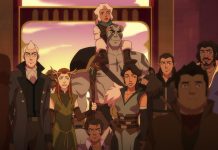We’re diving deep into issue #6 of Star Wars: The High Republic Adventures (Phase II) and how it hammers home the theme about differences making the community.
For those of us who have read the whole of The High Republic Phase II, we understand how the fighting on Jehda began. An extension of Eiram and E’ronoh’s war. A plot worked by the Path of the Open Hand.
These elements are briefly touched on in Sav Malagán’s story in The High Republic Adventures, enough to explain how all our characters end up on Jedha. Beyond that, it cares little for the inner workings of the politics of Eiram and E’ronoh or philosophies of the Path. Despite this distance, Adventures Issue #6 nevertheless ends up as a snapshot of the core theme of Phase II.
Hello There!
What’s this? Cinelinx jumping into The High Republic Adventures Phase II but only at the very end? You have acquired a stray: James Dillon!
I am a writer from the recently-closed journal, Eleven-ThirtyEight, where I wrote essays on each issue of the current Adventures run. The editor here, Jordan, was kind enough to offer me a space on Cinelinx to conclude my thoughts on this comic that has caught my heart since day one. But, if you’ve missed my previous entries and need to catch up, you can still find them at my old home:
- Issue #1: Sav Malagán, Community, & Identity – A Queer Lens on The High Republic Adventures
- Issue #2: The Function of Laughter in The High Republic Adventures
- Issue #3: On Disobedience and The High Republic Adventures
- Issue #4: “For the Moment, Let’s Call it Home” – Embodying Queerness in The High Republic Adventures
- Issue #5: Masculinity in The High Republic Adventures
The Scope of The High Republic
The High Republic—as a publication project—is a massive undertaking. As of this pre-Phase III moment, this era of Star Wars has been developed by eleven authors (not including reference materials) and twenty-five artists (not including letterers, cover artists, or voice actors), across fourteen publishers.
All trying to tell 1) an ungodly amount of individual tales for three different mediums and age ranges, and 2) one coherent, overarching story of the galaxy.
Pardon the Huttese – especially on a review of a children’s comic – but holy fuck.
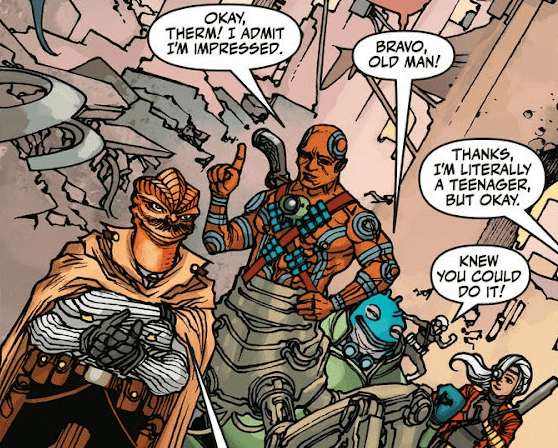
Coordinating such a project, I presume, would involve having clear goals that the creators could aim towards. From my reader perspective, it seems that the Events™ of each Phase were those goals. In Phase I, we have the Great Disaster, the attack on the Republic Fair, and the fall of Starlight. In Phase II, we have the Battle of Jedha and the Night of Sorrow. All stories in The High Republic, to one degree or another, bend towards these Events™.
In addition to the Events™, Phase II also seemed to have an overarching theme that drove all the conflict: understanding.
Throughout all the stories of Phase II, the day is saved or lost on the choice to understand the experience of someone different. We can leap across multiple books to see these various choices and their consequences: the marriage of Phan-Tu and Xiri (Convergence), the tragedy of Marda and Kevmo (Path of Deceit), the bickering of the Jehda Convocation (The Battle of Jedha), the journey of the Brightbird.
But in The High Republic Adventures, we have a chance to see these variations within a single issue. Characters step into the limelight, arcs come to a head, and fallout is based on the choice to understand.
I’m Literally a Teenager but Okay
Fresh off his limelight in Issue #5, Therm Scissorpunch inadvertently starts a brawl with the Path of the Open Hand. It’s the C-plot of the issue, a humorous string of events, that is still nevertheless predicated by the lack of understanding.
Therm does not understand the purpose of a child of the Path offering him a flower. He asks “Snip snip?” before snapping the flower in half. This causes the child to cry. Barbatash, an adult of the Path, proceeds to attack Therm (a teenager) without bothering to ask why Therm snipped the flower or even wonder if Therm (who has pincers for hands) could have physically done anything else to the flower.
Multiple people are drawn into a fight that sends everyone away with injuries, because an adult refused to even attempt to understand another perspective. Again, this is merely the humorous C-plot, but it’s still a succinct reflection of how the Battle of Jedha even began. The ambassadors of Eiram and E’ronoh refuse to understand each other or to understand Phan-Tu and Xiri, who seek peace between the two planets. They refuse to even try. And for it, a city burns.
Oil and Water
In the continuation of Adventures’ A-plot, we see a more fundamental disconnect. It’s not that Sav Malagán and Saya Keem refuse to understand each other. They come from similar backgrounds: restrictive childhoods from which they turned to piracy to escape. We watched them genuinely bond in Issue #4. After their break-up, we see them both mourn the loss of the relationship.
The issue here is a conflict of morals.
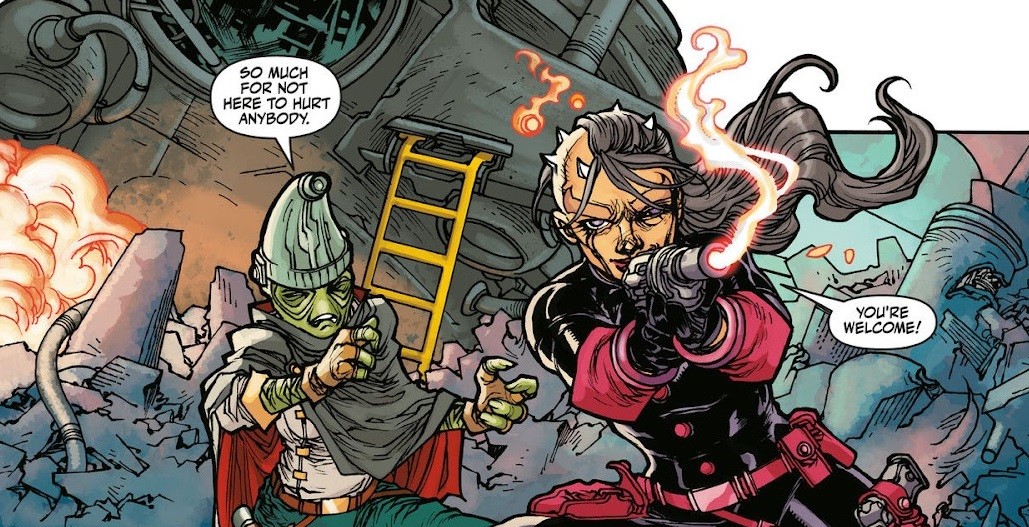
Saya’s core value seems to be her own independence, and her understanding of love and community seems to exist only on a one-to-one basis. Prior to Sav’s arrival, she relied on Drrn as a father figure. Once Sav shows up, Saya is willing to throw her entire community away to run away with the other girl and believes Sav would do the same for her.
Sav, after all, shares Saya’s value of independence. But it’s not Sav’s core value. Community is.
Due to her own limited understanding of community, Saya is unable to fathom where Sav’s heart lies. She is wholly unprepared for the extremes to which Sav is willing to go for Maz.
This conflict of morals also means that Saya and Sav keep each other at arms length. They both actively deceive each other, preventing that deeper connection.
Sav and Saya both want to understand each other, but the worlds they each choose drives them apart. A reflection of the tragedy that began this Phase of The High Republic. No matter how much Marda and Kevmo wanted to understand each other, their fundamental beliefs about the galaxy put them at odds.
The Only Good Cop is an Ex-Cop
The B-plot of Issue #6 – and arguably the B-plot of the entire comic – is another reflection of Sav and Saya, of Marda and Kevmo. The romance between Alak and Inspector Raf Thatchburn is the version of this story with a happily ever after.
Alak and Raf fell in love through understanding. They are two disabled men navigating worlds that were not built for them. However, these were opposite worlds: pirate and pirate hunter. Another conflict of morals, where incompatible beliefs drive these characters apart. Raf—the pirate hunter—in particular repeatedly refuses to understand Alak’s perspective. He deliberately isolates himself, clutching his legalistic worldview as a shield.
From Issues #1-#5, Raf has been Marda, who plunges deeper into the Path’s philosophy after that same philosophy leads to Kevmo’s murder. He has been Saya, who retreats into her independence after Sav chooses Maz’s community. Refusing to understand is a defense mechanism. As long as your worldview can justify it, there’s no need to unpack what you believe.
But Issue #5 leaves Raf in a situation that he wasn’t able to justify. Sav Malagán—a pirate—shows him trust and mercy. We find him adrift in Issue #6 because of this. His fundamental belief has been completely undercut. As a result, he spends all of his panels sad, confused, and asking questions.
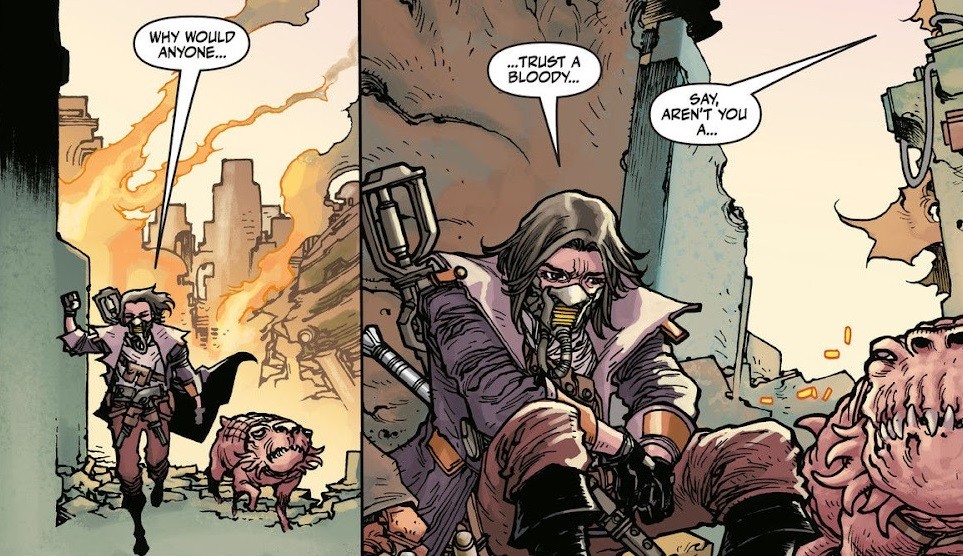
The journey to understand is a painful one for Raf, but it’s one that finally brings him and Alak together. Choosing to abandon harmful beliefs, choosing to understand, allows Raf and Alak the happy ending that neither Sav and Saya nor Marda and Kevmo received.
Signs of a Community
Every issue of The High Republic Adventures has made a point to showcase each member of Maz Kanata’s pirate crew. They are all given their moment in the limelight. And in the comic about being understood, the spotlight is shone on the girl who doesn’t have a tongue.
During their time on Jedha, Quiet Shan shares a short thread with Alak and Dex. In Issue #5, the two men are in deep discussion as Alak asks Dex for relationship advice. Dex shares that he understands his aromantic feelings towards Maz because “she makes me smile on the inside.” Alak shares how he and Raf fell for each other: that shared disabled experience. At times they both struggle to find the right thing to say. Dex says “I wish there was a simple word,” and Alak shakes his head with “Stars, listen to me…”
While the dialogue is limited to the two of them, panel space is given to Quiet Shan. She’s always just in the background, her eyes turned towards Dex and especially Alak, even in the middle of a battle.
Then, in Issue #6, we receive a rare moment of speech from Quiet Shan. Saving Raf’s life, she gives him the final push he needs to change his worldview. “You… make him… smile inside.” Five words reveal that she knew exactly what both Alak and Dex meant. Even through their faltering attempts, Quiet Shan listened, understood, and passed that understanding onto Raf.
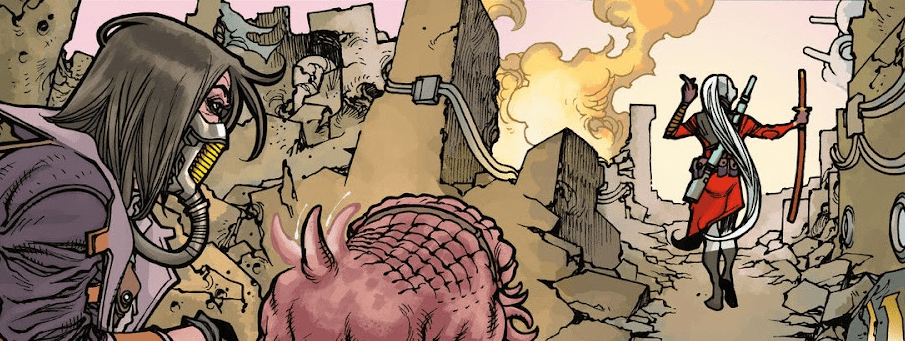
After saving Raf, she returns to the pirate crew, where we see her carry on a conversation with Alak and Dex, except she doesn’t speak. She signs her answers and questions, as the two men listen and understand her in return.
Through these moments, a picture is once again painted of what it’s like to live in the community of Maz Kanata’s crew. This hodge-podge of pirates is far from perfect. They have their awkward moments, their odd squabbles. Alak even snarks at Shan upon her return from saving Raf. But in Quiet Shan’s actions and in her conversation with Dex and Alak, we see that this community exists – thrives and grows – because they are people who choose to understand each other, even through disparate experiences.


